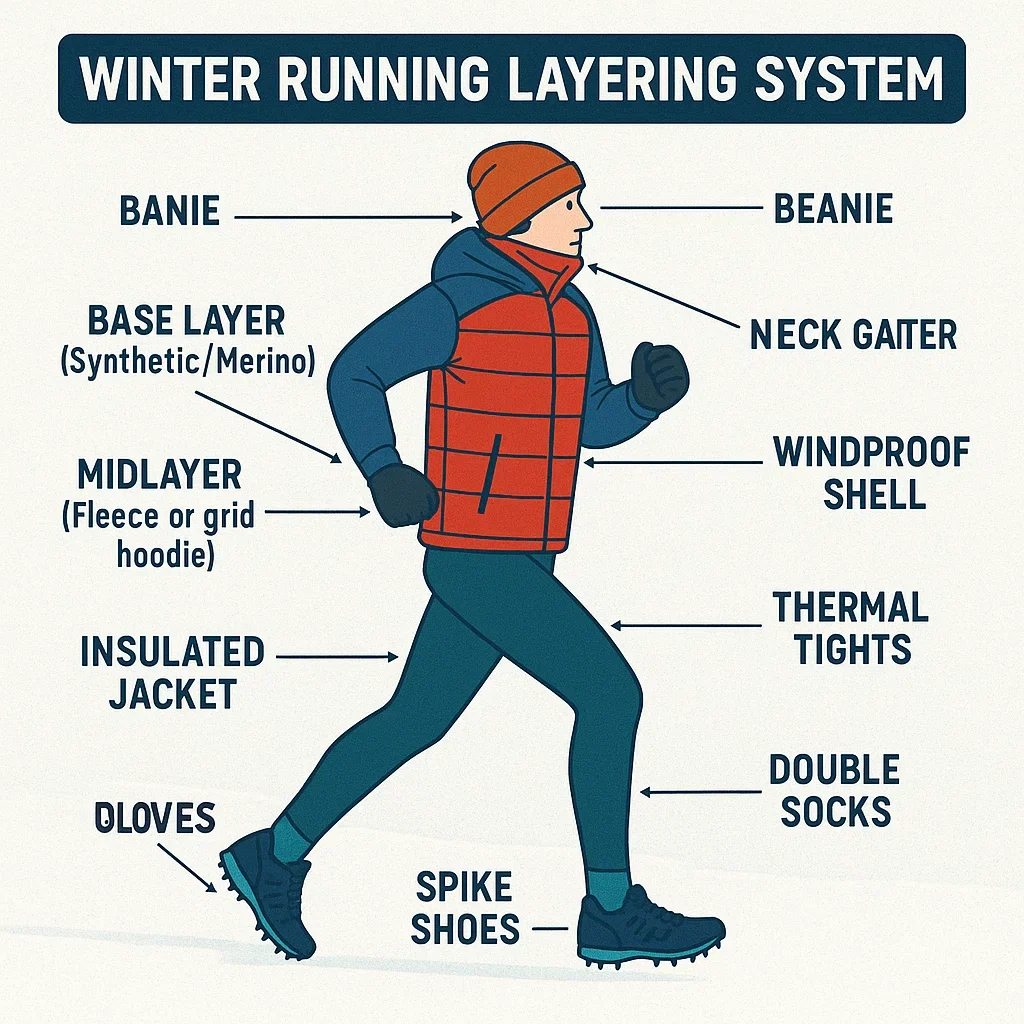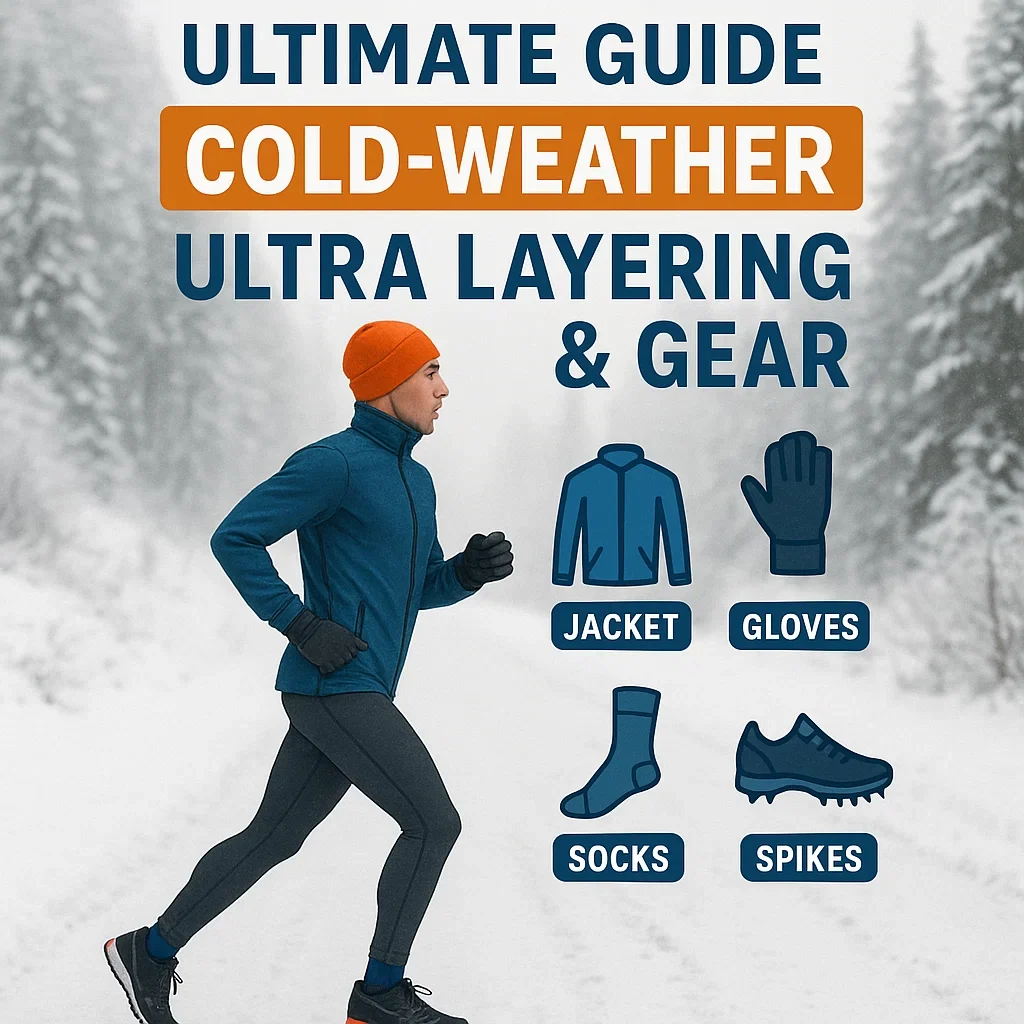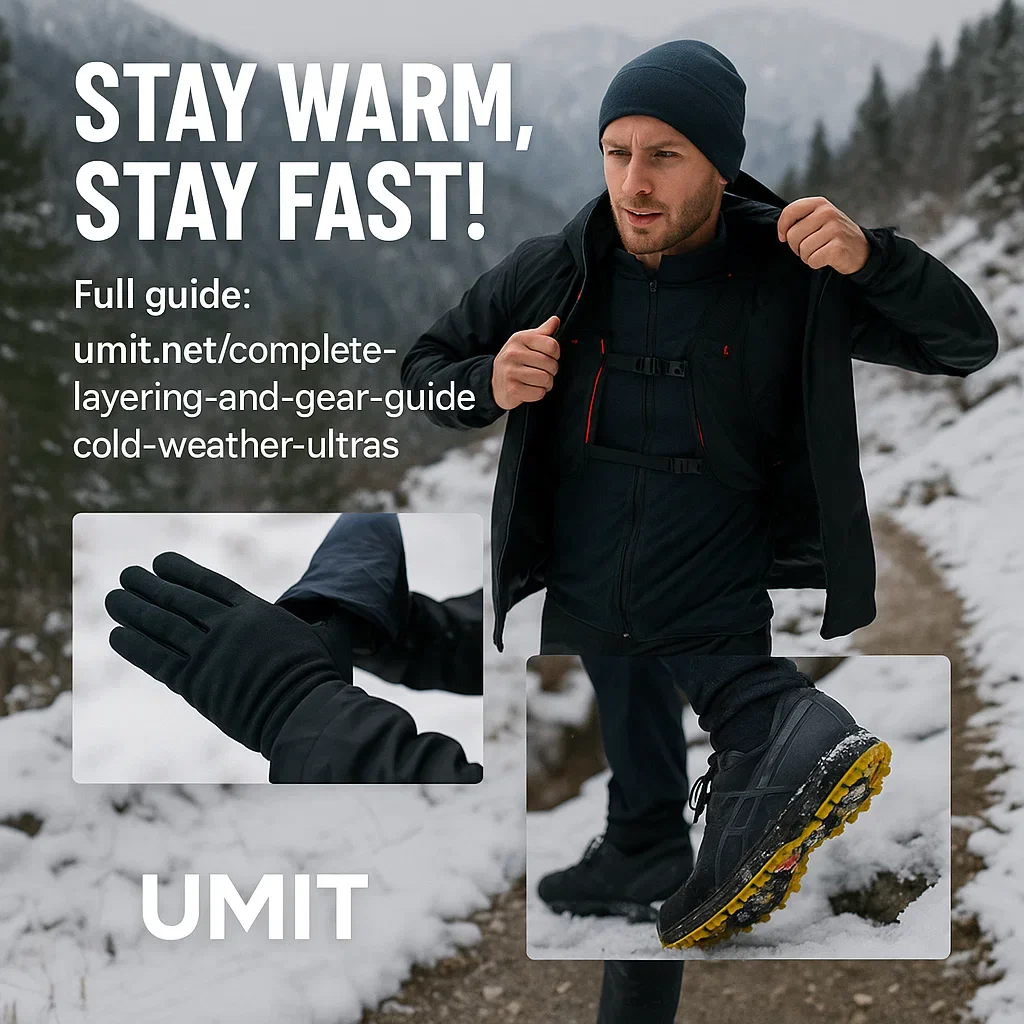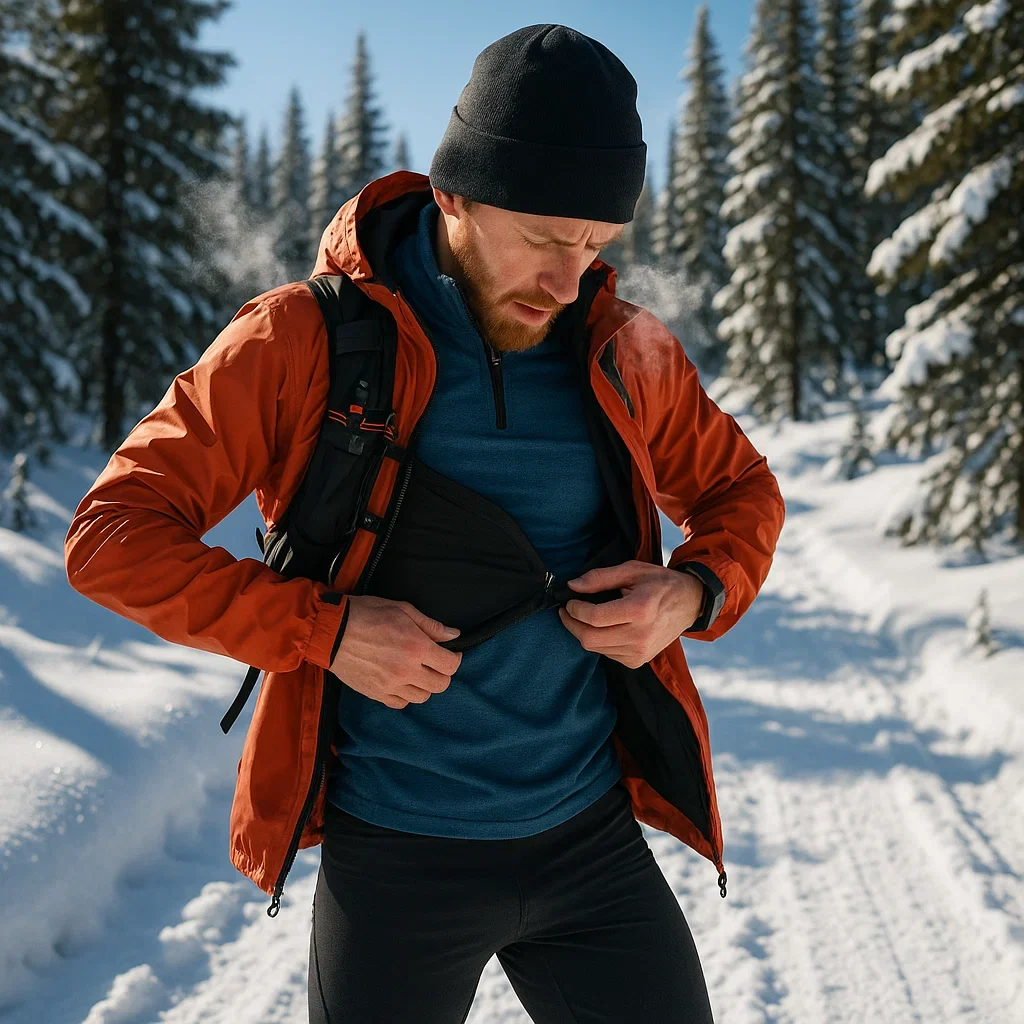🧥 Complete Layering & Gear Guide for Cold-Weather Ultras
Cold can humble any runner—even the elites. But with smart layering and the right winter gear, you can conquer snow ultras, stay warm, and finish strong. This guide is your blueprint for what to wear, how to adapt, and which brands deliver real performance in deep freeze conditions.
- ✔️ Proven layering systems for all conditions
- ✔️ Real runner reviews of top winter brands
- ✔️ Mistakes to avoid in freezing weather
- ✔️ Accessory hacks (gloves, socks, spikes & more)
- ✔️ Mini quizzes and expert gear tips throughout
The right layers do more than keep you warm—they keep you fast, dry, and confident when everyone else slows down. Don’t settle for “good enough” gear!
“Dialing in your layers is as important as your pacing. Never trust the forecast—pack options and practice quick changes during training!”
– Alex Reed, Yukon Arctic Ultra Top 10
🩳 Base Layers: Your First Defense Against the Cold
The base layer sits next to your skin. Its job: wick sweat fast and keep you dry—because moisture means cold. Get this right, and you’ll feel comfortable for hours. Get it wrong, and you’ll risk hypothermia before you see the first aid station!
- Synthetic (polyester/polyamide): Fastest wicking, dries quickly, stays light, lower cost. Great for short and intense efforts.
- Merino wool: Insulates even when damp, resists odors, softer on skin. Best for long races and all-day comfort.
- Cotton: Never use—absorbs sweat, dries slow, chills dangerously fast!
❓ Q&A: “Can I use a cycling or ski base layer?”
🧥 Midlayers: Warmth Without Sweat
Your midlayer is your thermostat. Worn over your base, it traps body heat but must vent sweat before you get soaked. Get it right, and you can cruise through snow squalls and open ridges. Get it wrong, and you’ll freeze as soon as you slow down!
- Grid fleece (e.g. Patagonia R1, Decathlon Run Warm+): Best warmth-to-weight, great for variable conditions.
- Lightweight insulated jacket (synthetic or active down): For races below –10°C or slow runners—packs small, big warmth when needed.
- Windshirt or ultralight vest: Adds a big buffer against sudden chills, especially if you stop moving.
- Avoid: Heavy, non-breathable jackets—they’ll soak you in sweat and weigh you down.
❓ Q&A: “What about down vs. synthetic?”

🧥 Outer Shells: Your Final Defense
Your outer shell is your shield. It blocks wind, snow, sleet, and even freezing rain—while letting sweat escape. The right shell means staying dry, warm, and fast in the worst weather.
- Wind jackets (Pertex/nylon): Featherlight, ultra-packable, perfect for dry, windy days. Block most chill but not rain.
- Waterproof-breathable shells (Gore-Tex, H2No, Decathlon Raincut): Keep you dry in snow, sleet, or heavy weather. Look for armpit zips and adjustable hoods.
- Softshells: Some stretch, wind and water-resistant, but heavier. Best for long, steady efforts—not for fast racing.
- Avoid: Heavy ski jackets or anything non-breathable—they trap sweat and chill you later.
❓ Q&A: “What’s better: full-zip or half-zip shells?”
🦵🧤 Legs, Hands & Accessories: Protect Your Weakest Links
Most runners DNF or suffer in cold ultras because their legs, hands, or accessories let them down—not their core. Smart planning for these “weak spots” keeps you moving when others are forced to stop!
- Legs: Thermal tights (merino or synthetic), double-layer if below –10°C, with windproof pants as backup. Some add a thin base layer or shorts for extra warmth.
- Hands: Liner gloves plus windproof mittens or insulated gloves. Bring 2–3 pairs. Chemical hand warmers for emergencies (and smartphone screens!).
- Feet: Wool socks (not cotton), consider double layers. Gaiters to keep out snow and wetness. Dry backup socks in a plastic bag = race saver.
- Head/Face: Beanie, buff/neck gaiter, windproof ear band. Face tape for extreme cold or windburn.
- Accessories: Sunglasses (snow glare hurts!), sunscreen, small scissors, chapstick, hand/foot warmers, safety pins, space blanket.
❓ Q&A: “Do I really need backup gloves and socks?”
🥾 Shoes & Spikes: Traction and Protection on Snow
No matter how good your fitness or layers, you won’t finish a snow ultra without traction. The right shoes and spikes keep you upright, fast, and injury-free—while the wrong setup means slips, falls, or quitting early.
- Trail Shoes: Look for grippy outsoles (Vibram, Contagrip, etc.), waterproof uppers, and a fit roomy enough for thick socks. Popular: Salomon Speedcross, Altra Lone Peak, Hoka Speedgoat, Inov-8 Roclite.
- Spikes/Traction Devices: Kahtoola EXOspikes (lightweight, great for mixed terrain), Kahtoola MICROspikes (aggressive, deep teeth for icy climbs), Hillsound Trail Crampon Ultra (for deep, soft snow), Yaktrax Pro (urban or groomed trail use).
- Pro tip: Always try spikes with your chosen shoes—fit can be very different depending on brand and model.
❓ Q&A: “What about waterproof shoes or Gore-Tex?”
🧣 Cold-Weather Accessories: The Details That Save Races
It’s the small things that make or break your race. The right accessories keep you comfortable, safe, and ready for anything the weather throws at you. Ignore them, and even the best layers won’t save your day!
- Buffs, balaclavas, face tape: Protect nose, cheeks, and mouth from frostbite & windburn.
- Gaiters: Keep snow and slush out of shoes and socks.
- Sunglasses/goggles: Stop glare, wind, and snow blindness.
- Lip balm & sunscreen: Yes, you burn and chap even in a blizzard.
- Chemical hand/foot warmers: Tiny, cheap, and can be a DNF-saver.
- Dry bags & ziplocks: Keep spare gloves, snacks, electronics dry and accessible.
- Safety pins, mini scissors, extra headlamp battery: Emergencies always happen at night or when coldest!
❓ Q&A: “Why do I need sunglasses for a winter race?”
🧩 Sample Layering Plans for Every Winter Ultra Scenario
There’s no single layering plan for every cold ultra. Success means adapting to weather, pace, terrain, and personal comfort. Use these proven setups as a starting point—then test and tweak for your needs!
❓ Q&A: “How do I practice my layering system?”
🚫 Top Layering Mistakes and How to Avoid Them
Even experienced runners blow their race with one simple mistake. Here’s how to dodge the most common layering fails and finish warm, dry, and smiling:
- Overdressing at the start: Leads to early sweat, then chilling—start cool, layer up only when needed.
- Wearing cotton anywhere: Cotton kills in cold—always choose wicking synthetics or merino wool.
- No backup gloves or socks: One wet or lost glove can end your race—always carry spares.
- Ignoring wind or wet forecasts: Plan for windchill, sleet, or surprise storms even on “good” days.
- Fiddly or untested gear: Try every zipper, pocket, and fit in real cold training—not just in your living room.
- Not practicing quick layer changes: Learn to swap layers fast with cold hands—practice at home and on long runs.
❓ Q&A: “Is it better to overdress or underdress slightly?”

✅ Step-by-Step Layering Checklist (Print or Screenshot!)
This checklist is your last line of defense before the starting gun. Use it the night before and the morning of your race—don’t trust your tired brain to remember everything at 4:00 a.m.!
- ✔️ Base Layer: Synthetic or merino, top & bottom—NO cotton!
- ✔️ Midlayer: Grid fleece, vest, or synthetic jacket—adapt to race temp.
- ✔️ Shell: Windproof or waterproof, easy to pack & put on with gloves.
- ✔️ Legs: Thermal tights, with backup wind pants or double layers for deep cold.
- ✔️ Feet: Wool socks (bring backup), tested shoes, spikes/traction devices, gaiters if needed.
- ✔️ Hands: Liner gloves, insulated mitts/gloves, at least one backup pair (ziplocked dry).
- ✔️ Head/Face: Beanie, buff/neck gaiter, windproof earband, face tape if needed.
- ✔️ Accessories: Sunglasses/goggles, sunscreen, lip balm, dry bags/ziplocks.
- ✔️ Emergency: Extra gloves & socks, chemical warmers, space blanket, safety pins, mini scissors.
- ✔️ Nutrition: Fuel in inner pocket, insulated water bottles/flasks, easy-open snacks.
- ✔️ Phone/electronics: Fully charged, packed close to your body, in a waterproof pouch.
❓ Q&A: “Is this list enough for extreme mountain ultras?”
🏁 Final Thoughts: Layer Up, Race Bold, Finish Proud
Winter ultras are a test of patience, planning, and self-respect—not just pure endurance. With the right layering strategy, you’ll stay comfortable, resilient, and in control—no matter how wild the weather gets. Every mile is a lesson, every finish is a story.
Share your wisdom below or ask your cold-weather gear question. Let’s help every runner stay warm and strong!
❓ Frequently Asked Questions
🧊 What’s the most important rule for winter ultra layering?
Always start a bit cold and use adjustable layers—avoid sweating, even if it means feeling chilly for the first 10–15 minutes!🧥 What’s the best base layer: synthetic or merino?
Both are excellent—synthetic dries fastest; merino insulates when wet and doesn’t stink. Try both in training!🚫 Why is cotton so bad in cold-weather ultras?
Cotton holds sweat, chills you fast, and never dries. It can be downright dangerous in the cold.🥶 What if I feel cold at the start line?
That’s ideal! You’ll warm up quickly once running—being “comfortable” before you start means you’re overdressed.🦵 Double tights or single tights for deep cold?
Double up below –10°C or if you get cold easily. Otherwise, thick thermal tights plus windproof pants work well for most runners.🧤 Gloves or mittens—which is warmer?
Mittens are always warmer, but gloves allow more dexterity. Carry both if possible!🧦 Do I really need to bring backup gloves and socks?
Yes! Wet, lost, or frozen hand/foot gear is a top reason for DNF. Spares are lifesavers.🥾 Should I use waterproof shoes or regular trail shoes?
Waterproof shoes help in slushy, wet snow—but can trap moisture if snow gets inside. Test both before race day.❄️ Are spikes mandatory for all winter ultras?
Not always, but most runners use spikes, microspikes, or crampons for safety and speed. Check race rules and terrain!🧣 Why do I need a buff or neck gaiter?
Protects your neck, face, and even mouth from frostbite and windburn. Essential on windy or exposed courses.🌞 Do I need sunscreen and sunglasses in winter?
Absolutely—snow glare burns skin and blinds eyes, even on overcast days. Protect yourself!📱 How do I keep my phone and battery alive in the cold?
Keep devices close to your body, insulated in a dry bag. Cold zaps battery life fast!🔋 Should I bring hand or foot warmers?
Highly recommended—lightweight, cheap, and a DNF-saver if temps plunge.🧢 Hat, beanie, or headband?
For most: thin beanie plus a headband for wind; a buff adds more warmth and coverage.🏁 When should I add or remove layers?
Adjust proactively—vent or remove layers before you sweat, and add warmth as soon as you slow down or stop.💦 How do I keep my water from freezing?
Use insulated bottles, keep them inside your vest, and refill with warm liquids at aid stations.🍫 My nutrition freezes—what do I do?
Keep gels/chews next to your skin, use softer or liquid calories, and set a timer to remind yourself to eat/drink regularly.🚶♂️ What’s the best way to practice my layering?
Do a full long run in race kit in real cold, including stops, climbs, and fast sections—test changing layers with gloves on!🚨 How do I avoid DNF from cold-related issues?
Layer wisely, bring spares, fuel often, and always have a plan B for worsening weather or gear fails.📝 Is there a perfect layering system?
No—every runner is unique. Use these principles, but tweak for your own sweat rate, cold tolerance, and terrain!
📝 Cold-Weather Ultra Layering Quiz
- What is the golden rule for winter ultra layering at the start line?
- Name two materials you should avoid for base layers.
- Why is overdressing at the start a common mistake?
- Which is warmer: gloves or mittens?
- Best place to stash gels or chews in –10°C?
- What’s the main job of your midlayer?
- Name one reason cotton is dangerous in cold ultras.
- How many pairs of gloves should you bring for a 100K in snow?
- Why is it important to bring backup socks?
- What’s the best footwear for deep snow and ice?
- Name one accessory that helps prevent frostbite on the face.
- What is the risk if your water bottle freezes during the race?
- Should you adjust layers before or after you get cold?
- Which item drains battery fastest in subzero conditions: phone, GPS watch, or headlamp?
- What’s the role of gaiters in snow ultras?
- Which type of jacket is a poor choice for an ultra: wind shell, waterproof-breathable, or heavy ski parka?
- Best practice for checking your race-day gear kit?
- Name two mistakes that lead to early DNF in cold races.
- What does “venting” mean in layering strategy?
- Why test every item in a full dress rehearsal?
✅ Quiz Answers
- Start slightly cold; don’t overdress
- Cotton, bamboo, or any non-wicking material
- You’ll sweat early, then freeze as pace drops
- Mittens (they trap more warmth)
- Close to your body/inside vest—prevent freezing
- Trap heat, insulate without trapping sweat
- It traps sweat, chills you, dries slow
- At least two pairs, one backup dry (or more)
- Wet feet chill fast and blister easily
- Grippy trail shoes + tested spikes/microspikes
- Buff, balaclava, or face tape
- You’ll risk dehydration, bonking, and cold stress
- Before! Be proactive, not reactive
- Phone (batteries hate cold the most)
- Keep snow out of shoes/socks
- Heavy ski parka—overheats, non-breathable
- Lay out/check off every item before bed
- Frozen hands/feet, overdressing, wet layers, ignoring forecast
- Opening zips/vents to release heat and sweat
- To make sure everything works, fits, and is quick to put on—no surprises on race day!
Share your score and quiz a friend! 🚀
📚 Further Reading & Resources
- iRunFar – Winter Ultramarathon Gear Guide — Real-world reviews and cold race tips
- Outside – How to Layer for Winter Running — Detailed breakdown of winter running layers
- Runner’s World – Best Winter Running Gear — Editor-tested gear picks for cold-weather training
- NCBI – Hypothermia in Endurance Events — Medical research & prevention
👟 Runner Perspectives: Beginner vs. Advanced vs. Elite
How to Layer for Cold Weather Running
Discover effective layering techniques to stay warm and dry during cold-weather runs, including base layers, mid-layers, and outer shells.
Winter Running Gear Essentials
Learn about the must-have gear for winter running, from thermal clothing to traction devices, ensuring safety and comfort in snowy conditions.
Fueling for Cold Weather Ultramarathons
Understand how to adjust your nutrition and hydration strategies to meet the demands of ultramarathons in freezing temperatures.
Recognizing and Preventing Hypothermia in Endurance Events
Identify the signs of hypothermia and learn preventive measures to stay safe during long-distance races in cold environments.
Best Snow Spikes for Winter Trail Running
Explore top-rated snow spikes and traction devices to enhance stability and safety on icy and snowy trails.
Cold Weather Running Tips from Elite Ultrarunners
Gain insights from professional ultrarunners on training, gear selection, and mental strategies for tackling cold-weather races.

About the Author
Lost Pace is an ultramarathon runner, shoe-tester and the founder of umit.net. Based year-round in Türkiye’s rugged Kaçkar Mountains, he has logged 10,000 + km of technical trail running and completed multiple 50 K–100 K ultras.
Blending mountain grit with data, Lost analyses power (CP 300 W), HRV and nutrition to craft evidence-backed training plans. He has co-written 260 + long-form guides on footwear science, recovery and endurance nutrition, and is a regular beta-tester of AI-driven coaching tools.
When he isn’t chasing PRs or testing midsoles, you’ll find him sharing peer-reviewed research in plain English to help runners train smarter, stay healthier and finish stronger.
Ultrarunner · Data geek · Vegan athlete

